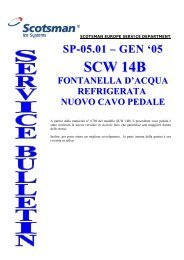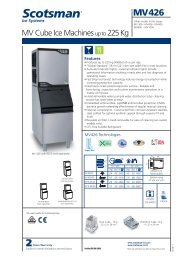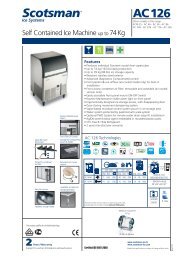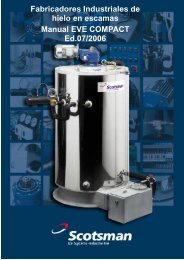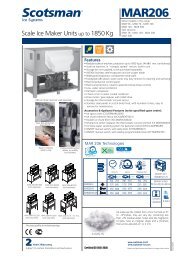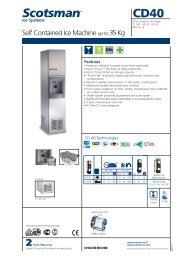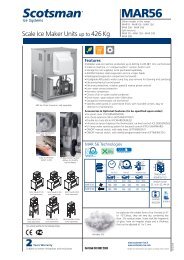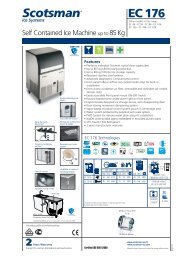Models And Technical Specifications May Change ... - Scotsman
Models And Technical Specifications May Change ... - Scotsman
Models And Technical Specifications May Change ... - Scotsman
Create successful ePaper yourself
Turn your PDF publications into a flip-book with our unique Google optimized e-Paper software.
“Rule-of-thumb” advice on how to choose the right ice maker,<br />
suitable to sustain expected ic e requirements<br />
Dice and Half Dice ice, Nugget ice, Scale ice…<br />
Each of these different types of ice is meant to meet and<br />
fulfil a specific requirement. They are produced by<br />
inherently different ice making machines. Other than by<br />
type of ice, differences may also be found in daily output<br />
capacity. More importantly, in the storage bin capacity,<br />
directly related to the footprint and the production volume<br />
of the units.<br />
The true parameter that should be followed when<br />
choosing an ice machine is the quantity of ice that the<br />
machine can hold in its storage bin, which equates to the<br />
actual quantity of ice that is available to the operator "here<br />
and now" as well as for the remainder of the evening<br />
hours.<br />
The refill capacity of ice machines during service hours is in<br />
fact relatively limited.<br />
Consider that the hourly output of a medium- small ice<br />
machine ranges from 2 kg per hour for medium-size<br />
models, going down to 0.8 kg per hour for the smallest<br />
units. It is strongly advisable to verify that the storage bin<br />
capacity is such that it will sustain your ice requirements<br />
from the early-on aperitives through to after-dinner<br />
digestives. Some of the smallest ice machines within the 20<br />
kg of daily production capacity, in fact, feature a storage<br />
bin capacity of only 4 kg!<br />
The first rule-of-the-thumb is that the storage<br />
bin capacity should ideally reflect 50% of<br />
the machines daily production. Keep in mind<br />
that once the storage bin is full, the ice machine<br />
producing ice. It will only restart when ice is<br />
removed from the storage bin.<br />
A storage bin that is unable to store the "closing<br />
hours production capacity" of the machine will<br />
therefore limit the daily actual capacity of the unit,<br />
whilst delivering only a limited amount of ice when the<br />
need is at its peak.<br />
In order to serve your customers with the “perfect<br />
drink” you need crystal-clear, pure, transparent and full<br />
cubes, to avoid “watering down” the drinks. In detail:<br />
a hollow cube, a "cube with the hole" will offer a larger<br />
heat exchange surface than a massive cube, which in turn<br />
will cause the cube to melt quicker. Hollow cubes usually<br />
melt prior to the average consumption time of the drink.<br />
Very quick cooling of the drink will therefore occur, as well<br />
as its (premature) warming up once the ice cubes have<br />
melted.<br />
A full cube, on the contrary, will chill the drink reflecting<br />
the consumption pattern: promptly, but not abruptly,<br />
durably and not prematurely, preserving the drink quality<br />
rather than diluting it.<br />
Massive cubes will last through the drink and more, for<br />
the enjoyment of those who love chewing on the<br />
residual ice cubes…<br />
A traditional bar, an “American Bar” that serves a limited<br />
volume of classic cocktails, may decide to work with a single,<br />
self-contained, Gourmet cube producing ice machine. In this<br />
case, special care should be paid in selecting the correct<br />
capacity of the storage bin: the best sellers in this segment are<br />
ice machines whose bins range between 8 and 15 kg, i.e.<br />
ice machines producing 20 to 30 kg of ice per day. Part of<br />
this production might be crushed for the preparation of<br />
tropical cocktails, unless a dedicated nugget ice machine is<br />
also available in the bar.<br />
Beverage consumption in Disco’s is typically higher, hence the<br />
requirement for larger capacity ice machines, for a generous<br />
ice supply. In this situation, we recommend the use of modular<br />
ice machines, where the production unit is matched<br />
with the storage bin, chosen according to the specific<br />
consumption patterns.<br />
A larger storage bin will accumulate and keep ice cubes<br />
during low volume week-days, and that higher quantity will<br />
come handy on high-volume week-end days. As the purchase<br />
cost of the ice machine is significantly higher than that of the<br />
bin, this simple trick may translate into significant savings. In<br />
other words, when ice consumption tends to concentrate in<br />
peaks during the week, a smaller ice machine may be<br />
purchased, and placed on the top of a larger than usual<br />
storage bin.<br />
For “round the week”, high volume Disco’s, we suggest<br />
that you consider more than just one large ice machine:<br />
several medium-size machines may be strategically positioned<br />
near the point-of-consumption of ice, thus reducing ice<br />
transportation and all related issues of potential contamination<br />
and extra labour.<br />
The smart choice in ice.<br />
18 19




